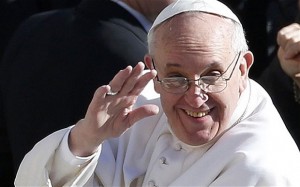The Weekly Francis is a compilation of the Holy Father’s writings, speeches, etc which I also cross-post at Jimmy Akin’s blog.
This version of The Weekly Francis covers material released in the last week from 15 October 2021 to 24 November 2021.
Angelus
General Audiences
Homilies
Messages
- 15 October 2021 – Message of the Holy Father to participants in the Ecclesial Assembly of Latin America and the Caribbean [21–28 November 2021]
- 20 November 2021 – Video Message of the Holy Father to the Daughters of Charity on the occasion of the General Assembly
- 23 November 2021 – Video Message of the Holy Father to mark the conclusion of the Plenary Assembly of the Pontifical Council for Culture
Speeches
- 19 November 2021 – To the Members of the Swedish Academy
- 19 November 2021 – To Participants in the International Conference ‘Eradicating Child Labor, Building a Better Future’
- 20 November 2021 – To Participants in the friendly football match between the World Rom Organization and ‘Fratelli tutti’
- 20 November 2021 – To Members of the Secular Institute of the COMI (Cooperatrici Oblate Missionarie dell’Immacolata)
- 22 November 2021 – To the participants in the ‘Christmas contest’ initiative
Papal Tweets
- “Dear young people, if our world is to arise, it needs your strength, your enthusiasm, your passion! Message” @Pontifex, 19 November 2021
- “Child labor is the exploitation of children. It is the denial of their rights to health, education, harmonious growth, to play, to dream. It means robbing children of their future, and therefore, humanity itself.” @Pontifex, 19 November 2021
- “Today Christ’s invitation to Paul is directed to every one of you young people: Get up! Do not remain on the ground ”feeling sorry for yourself“. There’s a mission waiting for you! You too can testify to what Jesus has begun to accomplish in you.” @Pontifex, 20 November 2021
- “The way we relate to children, the extent to which we respect their innate human dignity and fundamental rights, expresses what kind of adults we are and want to be, and what kind of society we want to build. #WorldChildrensDay” @Pontifex, 20 November 2021
- “It is my hope and prayer that each of you can joyfully say: “With Jesus, I too am a king”. I too reign: as a living sign of the love of God, of his compassion and his tenderness. #ChristTheKing Homily” @Pontifex, 21 November 2021
- “Dear young friends! Be free and authentic, be the critical conscience of society. Be passionate about truth, so that, with your dreams, you can say: “My life is not captive to the mindset of the world: I am free, because I reign with Jesus for justice, love and peace!” #WYD” @Pontifex, 21 November 2021
- “The kingship of Jesus is completely different than that of the world: He did not come to dominate but to serve. He did not come amid signs of power, but with the power of signs. He is not like other kings, but he is King for the others. #ChristTheKing” @Pontifex, 21 November 2021
- “If we put the #Gospel at the centre and bear witness to it with fraternal love, we will be able to look to the future with hope, whatever the tempests, great or small, we may experience today.” @Pontifex, 22 November 2021
- “Love rejoices in seeing others grow and suffers when others are anguished, lonely, sick, homeless, despised or in need. Love makes the heart leap; it brings us out of ourselves and creates bonds of sharing and communion.” @Pontifex, 23 November 2021
- “The Lord puts people who suffer on our path, people who feel alone or have lost their strength and courage. We must know how to recognize them and, with Saint Joseph’s help, become their friends and their support on the journey of life. #GeneralAudience” @Pontifex, 24 November 2021
- “The joy of the gospel fills the hearts and lives of all who encounter Jesus. Those who accept His offer of salvation are set free from sin, sorrow, inner emptiness and isolation. #EvangeliiGaudium Apostolic Exhortation” @Pontifex, 24 November 2021
Papal Instagram






